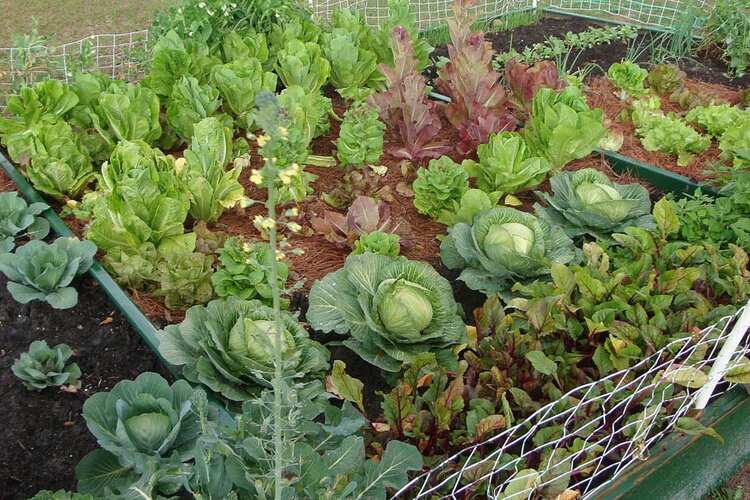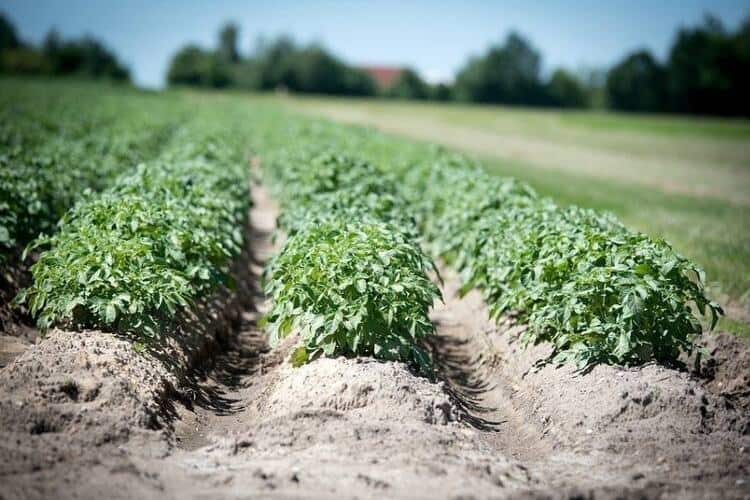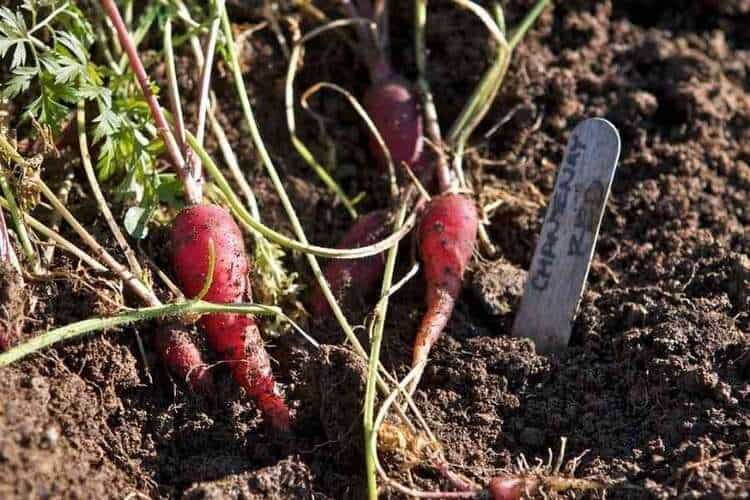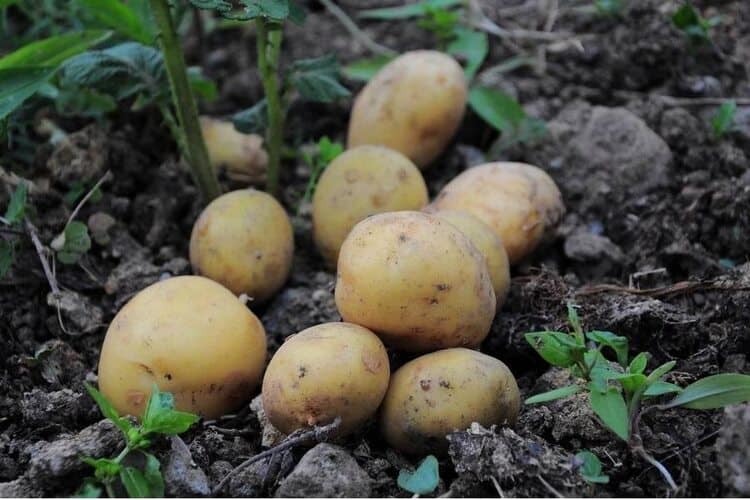How Many Potatoes Per Plant? (Revealing The Quantity)
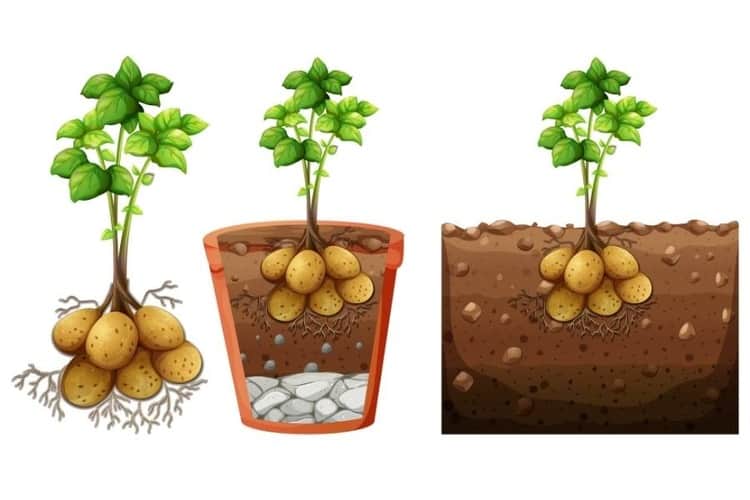
Mashed potatoes are one of the most nutrient-dense dishes in our kitchens. Wouldn’t it be faster, cheaper, and more fulfilling to produce your own potatoes at home instead of rushing to the grocery store? So, how many potatoes per plant?
The amount of care you provide the plants during the growing season and the variety of seed potatoes you plant impact their productivity. Keep reading to learn how to achieve a successful potato crop!
How Many Potatoes Does Each Plant Produce?
You can expect 5 to 6 potatoes per healthy plant. The size of these tubers may vary depending on how successfully you satisfy the plant’s growth requirements.
How To Maximize Yield For Your Garden Bed?
Buy Seed Potatoes
It is recommended to purchase certified seed potatoes from a vegetable garden or garden centre rather than a supermarket or convenience store, as these plants may have been treated to reduce sprouting. How many potatoes one plant produces depends on the seed potato’s positioning and several eyes. You can develop numerous plants from a single-seed potato.
If the seed potatoes are larger, cut them into pieces, making sure each piece has a couple of “eye” buds. Each of them will become a separate potato plant. In a plastic bag, combine the seed potatoes and banana peels. The banana peels will enhance the temperature in the bag, assisting the sprouting of the seed potato.
Alternatively, keep the seed potato in a drawer at room temperature. Please give them a three-day window to see whether they’ve begun growing. Planting a seed potato that has already sprouted from last year’s crop will increase potato yield.
For best results, place seed potatoes 14 inches apart in ditches 2 feet apart. If the distance between the seed potatoes is narrower than what we advised, the plants may not have enough space to develop a large number of tubers.
On average, you can expect to harvest 25 pounds of conventional potatoes for every pound of seed potatoes planted. With correct management and weather conditions, a 10-foot row of tubers may produce 10 to 20 pounds of tubers.
Potato Varieties
Various potato plant types produce different results. These tubers are first earlies, mid-season varieties, and main crop tubers.
Here are a few common potato varieties:
- Maris Bard (first, early)
- Almera (mid-season)
- Celine (first, early)
- Agria (main crop)
- Cara (maincrop)
- Maris Piper (main crop)
- Hermes (main crop)
- Kondor (main crop)
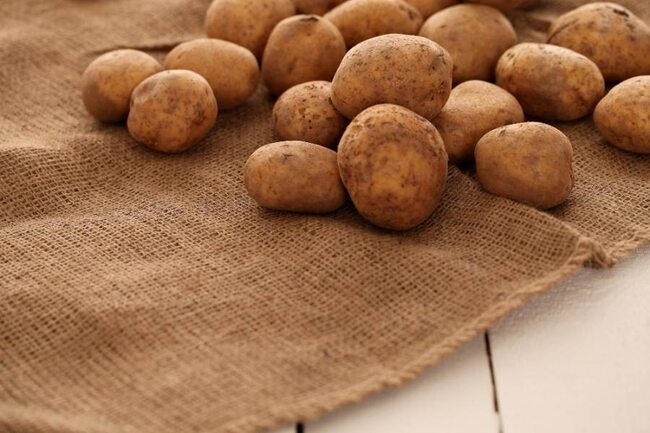
Techniques Of Growing Potatoes
Because regular potatoes grow underground towards the base of the plant’s stem, planting potatoes in a ridge ensures that the finely tilled soil covers all of the tubers, providing nutrients while minimizing waterlogging and weed growth.
Consider planting companion plants, such as beans, corn, cabbage, and eggplant, to ward off insects and promote potato growth. In hot weather, especially in the summer, heat can build up in above-ground grow bags, leading to a decrease in yield. The plants cease generating tubers when the soil temperatures rise above 75°F.
The tubers harvested will be smaller when cultivated in a narrower space, but they will be larger when cultivated in a broader space.
Read more: How Many Potatoes Per Plant? (Revealing The Quantity)
Soil and Fertilizers
There is no specific quantity of high-yielding plants that you can harvest when gardening. Depending on the circumstances you give for your regular ones, your product will either skyrocket or plummet. Because of adequate drainage, potatoes grow well on sandy and dry soil. Take a soil test before planting them to assess the drainage capacity and nutrients in the ground.
The pH of your soil significantly impacts how well the plant grows. Potatoes prefer a pH ranging from 5.0 to 6.5.
The consistent moisture will motivate your potato tubers to grow. Dry dirt can stifle their development and diminish yields, while moist soil will cause your developing tubers to rot.
Uneven soil moisture might cause cracking and browning in your plants. When getting close to the crop, strive to retain a moisture rate as low as possible since too much water will affect your yield.
Maintaining wet soil with regular watering, hilling the plants to bolster the stems, encouraging the formation of more tubers, and ensuring an adequate supply of nutrients through appropriate fertilizer can boost production.
Care Of Potato Plants
Potatoes grow best in a sunny spot with sandy, well-draining soil. They require wet soil and a 5-10-10 fertilizer before planting, as well as a side dressing in the midseason.
Growing potatoes on hills prevents sun exposure and helps prevent green tubers. Companion plants like beans, maize, cabbage, and eggplant can help keep insects away while promoting potato development.
Potatoes grow best in loam soil that drains well and is sunny. These plants require 5-10-10 fertilizers and moist soil during the growing season. Two parts garden soil to one part compost is the perfect mix for raised beds and hills. That will protect them grown on ridges from waterlogging and will also assist in preventing sunburn.
Plants with disease symptoms, such as lesions on leaves and stems, should be destroyed and killed as soon as possible.
What Is The Average Yield Of A Potato Plant?
Per Plant
The average output per one seed potato can vary depending on factors such as fertilization, watering, sunlight, and location.
Per Row
The yield per row can vary depending on factors such as planting conditions and varieties of potatoes. To achieve optimal yield, tubers should be planted 3 to 4 inches deep and 6 to 8 inches apart in rows 36 inches apart.
Per Pound
The average number of tubers per pound of potato seed can vary depending on factors such as growing conditions and potato varieties. If you get less than 6 pounds of tubers per pound of chopped grown ones, it might be the result of an unchecked pest infestation or a shortage of water during a vital growing time because the soil dries out.
How Long Do They Take To Grow?
You may harvest potatoes as soon as they reach the desired size. The time it takes for potatoes to grow can vary depending on factors such as weather and potato type. About 120 days after planting, full-sized yellow tubers are ready. Gardeners with a lot of experience may tell how far their crop has progressed by looking for a noticeable bulging of dirt around the plant’s stem.
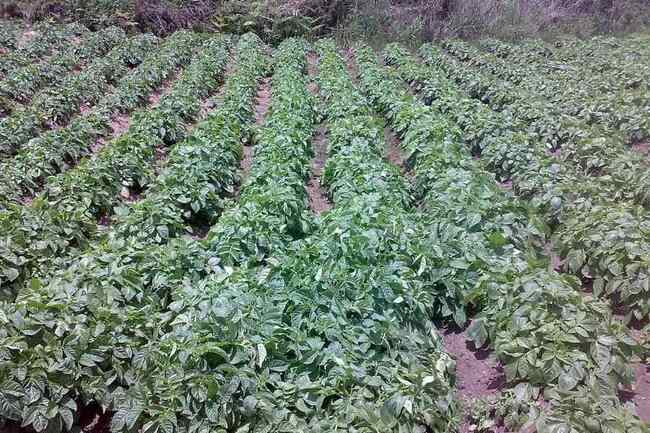
How Deep Do They Grow?
The depth of soil needed for potatoes to grow can vary depending on factors such as potato cultivar and growing conditions. You may need to add up to 12 inches more soil above the surface during the growing season.
Of course, specific potato cultivars will have root systems that are deeper and broader than others. If you’re growing potatoes in a container, they should be at least 24 inches tall to give them ample room.
Here’s how we break down the depth:
- Ten inches below the soil line includes adequate soil to hold potato roots and tubers.
- For an easy way to form hills, draw up dirt from each side of the row to support the stems, leaving only twelve inches of the plant growth exposed.
- The two-inch top provides additional material for later in the season. For example, to retain water before the soil dries out and give insulation from temperature variations, you might want to incorporate some fertilizer into the poor soil or put a thin layer of mulch on top of the soil to retain moisture.
What Is The Best Time Of Year To Plant Potatoes?
The best time to plant potatoes can vary depending on factors such as climate and frost dates. It would help to plant them two to three weeks before your last frost date for the best results. You may plant a second crop as late as June 15 and crop the tubers as late as feasible if you want to lengthen the storage duration and have a long growing season.
Where Is The Best Place To Grow Potatoes?
The best soil conditions for growing potatoes can vary depending on factors such as soil type and pH levels. These bulbs thrive on somewhat acidic soil with a PH of 5.0 to 7.0.
Conclusion
Because there are so many variables, you cannot know precisely how many potatoes one plant can produce. However, if you provide the plants under the appropriate circumstances, you may increase the yield for your raised bed.
If you follow the steps outlined in this article, you can ensure you have enough potatoes in the kitchen. If all conditions are reasonable, you may expect to harvest 5 to 14 potatoes per plant for your gardening efforts. Whether you grow trees for a hobby or as a food supply, you need some tips to save you time and money. You can find many other plant care tips on this site.
Related posts:


